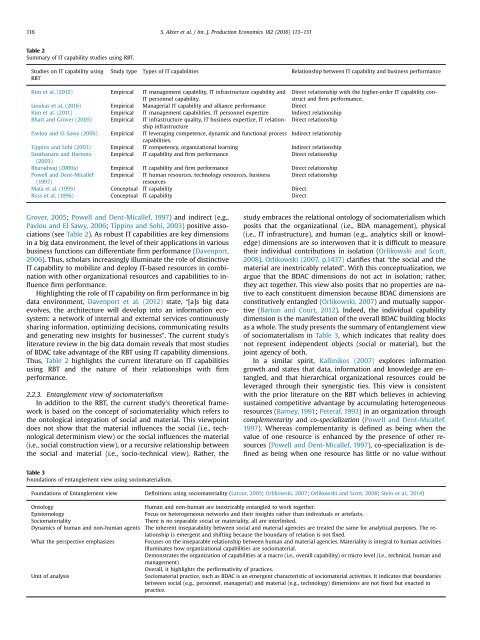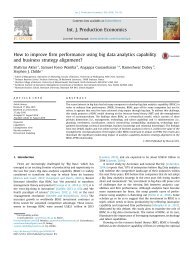Akter, S., Wamba, S. F., Gunasekaran, A., Dubey, R., & Childe, S. J. (2016). How to improve firm performance using BDAC and business strategy alignment.
You also want an ePaper? Increase the reach of your titles
YUMPU automatically turns print PDFs into web optimized ePapers that Google loves.
116<br />
S. <strong>Akter</strong> et al. / Int. J. Production Economics 182 (<strong>2016</strong>) 113–131<br />
Table 2<br />
Summary of IT capability studies <strong>using</strong> RBT.<br />
Studies on IT capability <strong>using</strong><br />
RBT<br />
Study type Types of IT capabilities Relationship between IT capability <strong>and</strong> <strong>business</strong> <strong>performance</strong><br />
Kim et al. (2012) Empirical IT management capability, IT infrastructure capability <strong>and</strong><br />
IT personnel capability.<br />
Direct relationship with the higher-order IT capability construct<br />
<strong>and</strong> <strong>firm</strong> <strong>performance</strong>.<br />
Lioukas et al. (<strong>2016</strong>) Empirical Managerial IT capability <strong>and</strong> alliance <strong>performance</strong> Direct<br />
Kim et al. (2011) Empirical IT management capabilities, IT personnel expertize Indirect relationship<br />
Bhatt <strong>and</strong> Grover (2005) Empirical IT infrastructure quality, IT <strong>business</strong> expertize, IT relationship<br />
Direct relationship<br />
infrastructure<br />
Pavlou <strong>and</strong> El Sawy (2006) Empirical IT leveraging competence, dynamic <strong>and</strong> functional process Indirect relationship<br />
capabilities.<br />
Tippins <strong>and</strong> Sohi (2003) Empirical IT competency, organizational learning Indirect relationship<br />
Santhanam <strong>and</strong> Har<strong>to</strong>no Empirical IT capability <strong>and</strong> <strong>firm</strong> <strong>performance</strong> Direct relationship<br />
(2003)<br />
Bharadwaj (2000a) Empirical IT capability <strong>and</strong> <strong>firm</strong> <strong>performance</strong> Direct relationship<br />
Powell <strong>and</strong> Dent-Micallef Empirical IT human resources, technology resources, <strong>business</strong> Direct relationship<br />
(1997)<br />
resources<br />
Mata et al. (1995) Conceptual IT capability Direct<br />
Ross et al. (1996) Conceptual IT capability Direct<br />
Grover, 2005; Powell <strong>and</strong> Dent-Micallef, 1997) <strong>and</strong> indirect (e.g.,<br />
Pavlou <strong>and</strong> El Sawy, 2006; Tippins <strong>and</strong> Sohi, 2003) positive associations<br />
(see Table 2). As robust IT capabilities are key dimensions<br />
in a big data environment, the level of their applications in various<br />
<strong>business</strong> functions can differentiate <strong>firm</strong> <strong>performance</strong> (Davenport,<br />
2006). Thus, scholars increasingly illuminate the role of distinctive<br />
IT capability <strong>to</strong> mobilize <strong>and</strong> deploy IT-based resources in combination<br />
with other organizational resources <strong>and</strong> capabilities <strong>to</strong> influence<br />
<strong>firm</strong> <strong>performance</strong>.<br />
Highlighting the role of IT capability on <strong>firm</strong> <strong>performance</strong> in big<br />
data environment, Davenport et al. (2012) state, “[a]s big data<br />
evolves, the architecture will develop in<strong>to</strong> an information ecosystem:<br />
a network of internal <strong>and</strong> external services continuously<br />
sharing information, optimizing decisions, communicating results<br />
<strong>and</strong> generating new insights for <strong>business</strong>es”. The current study’s<br />
literature review in the big data domain reveals that most studies<br />
of <strong>BDAC</strong> take advantage of the RBT <strong>using</strong> IT capability dimensions.<br />
Thus, Table 2 highlights the current literature on IT capabilities<br />
<strong>using</strong> RBT <strong>and</strong> the nature of their relationships with <strong>firm</strong><br />
<strong>performance</strong>.<br />
2.2.3. Entanglement view of sociomaterialism<br />
In addition <strong>to</strong> the RBT, the current study’s theoretical framework<br />
is based on the concept of sociomateriality which refers <strong>to</strong><br />
the on<strong>to</strong>logical integration of social <strong>and</strong> material. This viewpoint<br />
does not show that the material influences the social (i.e., technological<br />
determinism view) or the social influences the material<br />
(i.e., social construction view), or a recursive relationship between<br />
the social <strong>and</strong> material (i.e., socio-technical view). Rather, the<br />
study embraces the relational on<strong>to</strong>logy of sociomaterialism which<br />
posits that the organizational (i.e., BDA management), physical<br />
(i.e., IT infrastructure), <strong>and</strong> human (e.g., analytics skill or knowledge)<br />
dimensions are so interwoven that it is difficult <strong>to</strong> measure<br />
their individual contributions in isolation (Orlikowski <strong>and</strong> Scott,<br />
2008). Orlikowski (2007, p.1437) clarifies that “the social <strong>and</strong> the<br />
material are inextricably related”. With this conceptualization, we<br />
argue that the <strong>BDAC</strong> dimensions do not act in isolation; rather,<br />
they act <strong>to</strong>gether. This view also posits that no properties are native<br />
<strong>to</strong> each constituent dimension because <strong>BDAC</strong> dimensions are<br />
constitutively entangled (Orlikowski, 2007) <strong>and</strong> mutually supportive<br />
(Bar<strong>to</strong>n <strong>and</strong> Court, 2012). Indeed, the individual capability<br />
dimension is the manifestation of the overall <strong>BDAC</strong> building blocks<br />
as a whole. The study presents the summary of entanglement view<br />
of sociomaterialism in Table 3, which indicates that reality does<br />
not represent independent objects (social or material), but the<br />
joint agency of both.<br />
In a similar spirit, Kallinikos (2007) explores information<br />
growth <strong>and</strong> states that data, information <strong>and</strong> knowledge are entangled,<br />
<strong>and</strong> that hierarchical organizational resources could be<br />
leveraged through their synergistic ties. This view is consistent<br />
with the prior literature on the RBT which believes in achieving<br />
sustained competitive advantage by accumulating heterogeneous<br />
resources (Barney, 1991; Peteraf, 1993) in an organization through<br />
complementarity <strong>and</strong> co-specialization (Powell <strong>and</strong> Dent-Micallef,<br />
1997). Whereas complementarity is defined as being when the<br />
value of one resource is enhanced by the presence of other resources<br />
(Powell <strong>and</strong> Dent-Micallef, 1997), co-specialization is defined<br />
as being when one resource has little or no value without<br />
Table 3<br />
Foundations of entanglement view <strong>using</strong> sociomaterialism.<br />
Foundations of Entanglement view Definitions <strong>using</strong> sociomateriality (La<strong>to</strong>ur, 2005; Orlikowski, 2007; Orlikowski <strong>and</strong> Scott, 2008; Stein et al., 2014)<br />
On<strong>to</strong>logy<br />
Human <strong>and</strong> non-human are inextricably entangled <strong>to</strong> work <strong>to</strong>gether.<br />
Epistemology<br />
Focus on heterogeneous networks <strong>and</strong> their insights rather than individuals or artefacts.<br />
Sociomateriality<br />
There is no separable social or materiality, all are interlinked.<br />
Dynamics of human <strong>and</strong> non-human agents The inherent inseparability between social <strong>and</strong> material agencies are treated the same for analytical purposes. The relationship<br />
is emergent <strong>and</strong> shifting because the boundary of relation is not fixed.<br />
What the perspective emphasizes<br />
Focuses on the inseparable relationship between human <strong>and</strong> material agencies. Materiality is integral <strong>to</strong> human activities<br />
Illuminates how organizational capabilities are sociomaterial.<br />
Demonstrates the organization of capabilities at a macro (i.e., overall capability) or micro level (i.e., technical, human <strong>and</strong><br />
management)<br />
Overall, it highlights the performativity of practices.<br />
Unit of analysis<br />
Sociomaterial practice, such as <strong>BDAC</strong> is an emergent characteristic of sociomaterial activities. It indicates that boundaries<br />
between social (e.g., personnel, managerial) <strong>and</strong> material (e.g., technology) dimensions are not fixed but enacted in<br />
practice.




